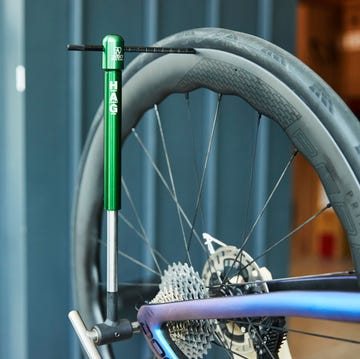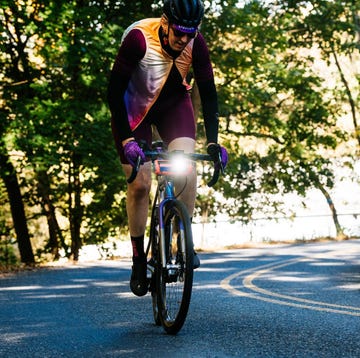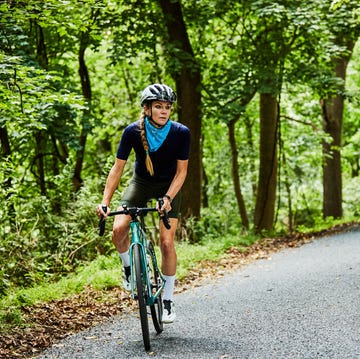If you’re not sure how to set your cycling goals, look to your peers. Learning the average cycling distance of those in your age group can help you better understand how long and far you can ride, especially if you’re not sure where to start. Also, getting to know the average cycling distance can help you better plan your time in the saddle and nutrition needs for future rides.
To help you put things into perspective, we gathered the average cycling distance by age from Strava and Ride with GPS. We also spoke with a cycling coach to explain what it takes to complete these distances so you can set realistic expectations for future rides.
The Average Cycling Distance By Age
The average cycling distance traveled in the U.S. ranges from 11.8 miles to 22.8 miles, according to data pulled from Strava and Ride with GPS.
Here’s a more detailed breakdown on the average cycling distance for users of various ages on both platforms. Also, you’ll find the average distance of routes created (but not necessarily completed) on Ride with GPS.
Strava
These are median distances completed by Strava users categorized by generation, according to the 2023 End of the Year In Sport Report.
- 13-26 years old (Gen Z): 14.0 miles
- 27-41 years old (Millennials): 13.8 miles
- 42-57 years old (Gen X): 17.4 miles
- 58-76 years old (Boomers): 20.9 miles
Ride with GPS
These are the average cycling distances by age for rides completed in the last five years.
The overall average distance for Ride with GPS users was 18 miles.
- 20-30 years old: 16.6 miles
- 30-40 years old: 18.1 miles
- 40-50 years old: 18.5 miles
- 50-60 years old: 19.7 miles
- 60-70 years old: 22.0 miles
- 70-80 years old: 22.3 miles
- 80-90 years old: 19.2 miles
These are the average distances of routes planned by riders on the platform, but it’s unclear whether or not riders actually completed them.
The overall average planned route distance was 46.2 miles.
- 20-30 years old: 48.8 miles
- 30-40 years old: 48.5 miles
- 40-50 years old: 50.1 miles
- 50-60 years old: 48 miles
- 60-70 years old: 44.5 miles
- 70-80 years old: 38.4 miles
- 80-90 years old: 35 miles
What the Average Cycling Distance Doesn’t Tell You
These average cycling distance statistics can help you better understand what riders in your age group are capable of, as well as the capabilities of those that are older or younger than you.
However, there are a few things that these stats don’t take into consideration like how long it took to ride the distance or whether or not the ride was cut short due to any unexpected complications like a flat tire, discomfort, or bonking.
Here’s how you can make sure you complete the distances you set out to cover.
How to Make Sure You Hit Your Goal Riding Distance
One of the big factors in not succeeding in covering a certain distance would be comfort, especially if the bike isn’t fitted properly, says Kristen Phillips, USA Cycling certified coach and owner of the Art of Cycling. “In the context of a human body on a bike, there’s three points of contact: the hands, the sit bones, and the feet,” she says. If you experience numbness or discomfort at any of these contact points when riding for more than 10 miles, this could be an indication your bike fit is off, says Phillips. It could also be the reason why you cut a ride short.
To go the distance, Phillips suggests dialing in your bike fit, and more specifically, paying attention to the width of your handlebar, saddle width and height, and shoe size.
In terms of the width of your handlebar, it should come close to matching the width of your shoulders.
To find the best saddle for you, measure the width of your sit bones, which you can do at your local bike shop if they have the measuring tool to do so. Keep in mind, if your saddle is too-wide or too-narrow for your sit bones, this can lead to bike seat pain, especially on a long ride, says Phillips.
To find an ideal saddle height, sit on the seat and move one pedal to the bottom of the pedal stroke (about the 6 o’clock position). Reach your heel down to the pedal—it should just graze the pedal in this position.
Also, Phillips recommends going up a half size in cycling shoes, just as you would running shoes, to make room for feet swelling.
How to Determine How Long a Certain Distance Will Take
Another key component missing from the data set is time, which tends to vary depending on your age and fitness level. According to 2023 Strava data, the average cycling speed for leisure rides completed on pavement was 14.1 mph, and average distance for those rides was 19.2 miles. Leisure dirt rides were slower and shorter, on average: 8.6 mph and 10.6 miles.
A simple way to determine how long it would take you to ride a particular distance is dividing the distance by your average speed in miles per hour (mph), says Phillips.
Estimating how long it will take you to complete your goal distance is important because it plays into your nutrition—especially if you plan to ride for more than three hours.
If you’re going for a short ride (one hour or less) then you don’t need to worry about fueling preride because you likely have enough energy stored. But you want to make sure you’re hydrated, so bring water or potentially a low-carb electrolyte drink with you.
For rides lasting more than one hour, you’ll need to pack a bottle of water or an electrolyte drink and make sure you’re consuming 30 to 60 grams of carbs per hour—on the higher end if you’re going for more than three hours.
Phillips recommends you always pack an extra bar, just in case, regardless of how long you think you’ll ride.
How to Structure Your Workout Plan to Increase Your Cycling Distance
If you aren’t currently riding the average cycling distance for your age group, but want to, up your game by following a structured training plan, like our base building training plan, to increase your cycling distance, just as you would to improve your speed or endurance.
If you want the most success with the least amount of trial and error, Phillips recommends you find a periodized training plan, particularly one structured around a time and distance goal you’re trying to reach like riding a 50-miler in three hours. Ideally, each day and week should build on the next for three weeks, followed by an intentional rest week with fewer miles so your body can adapt, she says.
No matter what plan you choose, you want to gradually increase your mileage (by about 10 to 15 percent each week) to make sure you stay injury-free and excited for your next ride.

Monique LeBrun is a health and fitness editor who is based in Easton, Pennsylvania. She covers a wide range of health and wellness topics, with a primary focus on running performance and nutrition. Monique is passionate about creating content that empowers runners to become the best versions of themselves. As an avid runner and parent, she loves spending time outdoors with her daughter, who often accompanies her on weekend runs as her personal mini run coach.













